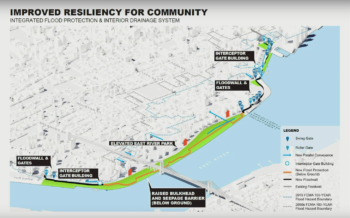
Rendering of proposed flood resiliency infrastructure prior to the Project’s approval. The construction will now begin. /Image Credit: DDC, Parks, DOT, DEP, and Mayor’s Office of Resiliency/CPC
The ambitious project will help to protect the East Side community and provide new improvements to many parks. On April 15, 2021, Mayor Bill de Blasio announced major construction on the East Side Coastal Resiliency Project. The $1.45 billion project will extend flooding protections and improve open spaces. Neighborhoods that were heavily affected by Hurricane Sandy in 2012 will now be home to one of New York City’s most ambitious infrastructure and climate justice projects. For CityLand’s prior coverage of the East Side Coastal Resiliency Project, click here.
The East Side Coastal Resiliency Project will include a 2.4 mile system of raised parkland, floodwalls, berms, and movable floodgates. These installations will protect against the growing threat of more severe coastal storms caused by climate change. The Project will also be providing upgrades to public open spaces and amenities. These include improvements to reconstructed bridges and sewer systems.
An above-ground floodwall is planned to protect Stuyvesant Cove Park that will eventually form an integrated flood protection system. Work on this improvement will begin with the installation of an underground wall of structural sheeting in the park.
A phased construction schedule is planned for the work in East River Park. Half of the park will remain open during the park. These phased construction plans are to be employed on other projects to allow public access to open space and recreational amenities throughout the project.
The flood protection heights will be about eight to nine feet above the existing grade. The project design was formed by keeping future storms like Hurricane Sandy in mind and by using climate projections made by the New York City Panel on Climate Change. The adaptive design could accommodate up to 2 more feet of elevation in case of more rising sea levels.
The Project will also be improving parks, playgrounds, and recreational facilities. Including:
East River Park: The waterfront park will be integrated into the Project to protect the park and the dense neighborhoods around it. The Park will be receiving new amenities including an amphitheater, sports fields, picnic areas, and new passive areas. Already existing areas will also be reconstructed and improved.
Corlears Hook Park: This park will have its bridge redesigned and will improve its landscaping and facilities.
Murphy Brothers Playground: This park will be getting newly updated recreation facilities and have a flood protector installed.
Stuyvesant Cove Park: This park will have new floodwalls and floodgates installed as well as new planting beds and irrigation systems. The park will also be receiving new paving and lighting. Its education center, the Solar One Environmental Education Center, will also be rebuilt and expanded by the Economic Development Corporation.
Asser Levy Playground: This park will be rebuilt with new landscaping, a new floodwall, and a new floodgate. Recreational facilities like the playground and basketball court will also be rebuilt.
Local parks and other open spaces have been receiving improvements from the City to ensure that residents still have access to parks and relaxing areas. The Department of Parks and Recreation has also planted 500 of a planned 1,000 trees in the community and over 1,800 will be planted in new parks. A new waterfront park will also be created south of East River Park.
The project has been discussed between the City and local communities since 2018. Three Community Construction Liaisons working with the Department of Design and Construction will provide updates on progress to the community. Progress on the projects can be tracked here.
Funding for the East Side Coastal Resiliency Project comes from the City and the U.S. Department of Housing and Urban Development. The Project team is led by the Department of Design and Construction, the Department of Parks and Recreation, and the Mayor’s Office of Resiliency. The City projects that the project will be completed by the Department of Design and Construction by 2025.
Mayor Bill de Blasio stated, “Building a recovery for all of us means fighting climate change and investing in resilient communities. This project will keep generations of New Yorkers safe from extreme weather, coastal storm, and rising sea levels – all while preserving and improving some of our city’s most iconic open spaces. This city will lead the way in preparing for the worst effects of climate change and ensuring we bounce back faster and stronger from the next major storm.”
NYC Department of Design and Construction Commissioner Jamie Torres-Springer stated, “At every step through design and approvals we have worked to ensure the constructability of the project while addressing the community’s concerns about access to parkland and construction impacts such as noise and traffic, and the current project achieves that.”
By: Patrick McNeill (Patrick is the CityLaw intern and a New York Law School student, Class of 2022.)


This project is controversial–there are two lawsuits pending against it. Neighborhood residents have protested vigorously because it is a destructive, environmentally unjust, expensive project that is using brute force 20th century solutions that didn’t work to deal with climate change.. Better solutions are available for flood control. Please cover this issue in more depth. It is a massive boondoggle.